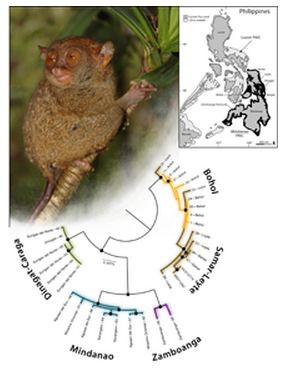New Species of Tarsier Discovered in the Philippines
| Marc Maligalig | | Aug 20, 2014 08:21 PM EDT |
(Photo : University of Kansas) The Dinagat-Caraga tarsier, its habitat and distribution in the Philippines
American researchers have discovered a new species of Philippine tarsier, a new genetic type of primate found mostly in a small island off the coast of Mindanao in southern Philippines.
They confirm the "Dinagat-Caraga tarsier" is an evolutionary lineage of primate different from tarsiers in the island of Bohol in the Visayas region. This new tarsier (pronounced "tar-seer") species is found mostly on the Dinagat Islands off the northern coast of Surigao del Norte province in Mindanao.
Like Us on Facebook
Research conducted by Rafe Brown from the Biodiversity Institute at the University of Kansas and his colleagues confirmed the existence of the Dinagat-Caraga tarsier, which is a completely new variety.
"Previously tarsiers were one species, divided into three named subspecies," Brown said.
"Our data disagree with that subspecies arrangement and instead demonstrate that the Philippine tarsiers are divided into three genetic units-but these units are from different localities than the named taxa.
"So our data provide an objective way to restructure conservation efforts and point the resources where they need to go, in order to really have an effective impact on preserving genetic diversity in the group."
The researchers have published a paper in the journal PLOS ONE about the genetic distribution and diversity of the new tarsier species. This new information about the primates could provide essential information in protecting the tarsier from extinction.
"It's really not like any animals that Americans are familiar with," said Brown.
"A tarsier has giant eyes and ears; an extremely cute, furry body; a long tail with a furry tuft at the end; and interesting expanded fingers and toe tips that look a bit like the disks on the digits of tree frogs."
The tarsier has become a flagship symbol of Philippine ecotourism and environmental stewardship.
It's, however, threatened by habitat loss because of mining, development and illegal logging rampant in the Philippines. Unfortunately, thousands of the primates are captured and sold to tourists who wind up killing the animal.
The tarsier has sparked numerous conservation efforts but a lack of information about the creature is hindering these efforts. Conservationists face a number of problems in saving the tarsier and there have been too few studies of the animal in the field.
Almost no information is found on the tarsier's taxonomic diversity. The scarcity of DNA samples and representative specimens of the species in biodiversity facilities have shed no light on questions currently asked.
In order to save the tarsier, experts require more data about the species.
"Basically, we cannot legally protect something if we do not know that it exists," Brown said.
He added that the results suggest a new protected area "in the ranges of each of the genetic units if our goal is to maximally preserve the genetic underpinnings of that biodiversity."
The findings should help restructure conservation targets for Philippine tarsiers. Conservationists expect a much greater urgency to protect the Dinagat-Caraga tarsier on Dinagat Island and tarsiers in Mindanao's Caraga Region.
TagsTarsier, Conservation, Habitat, Philipppines, Mining, Logging, endangered species, trading of endangered species
©2015 Chinatopix All rights reserved. Do not reproduce without permission
EDITOR'S PICKS
-

Did the Trump administration just announce plans for a trade war with ‘hostile’ China and Russia?
-

US Senate passes Taiwan travel bill slammed by China
-

As Yan Sihong’s family grieves, here are other Chinese students who went missing abroad. Some have never been found
-

Beijing blasts Western critics who ‘smear China’ with the term sharp power
-

China Envoy Seeks to Defuse Tensions With U.S. as a Trade War Brews
-

Singapore's Deputy PM Provides Bitcoin Vote of Confidence Amid China's Blanket Bans
-

China warns investors over risks in overseas virtual currency trading
-

Chinese government most trustworthy: survey
-

Kashima Antlers On Course For Back-To-Back Titles
MOST POPULAR
LATEST NEWS
Zhou Yongkang: China's Former Security Chief Sentenced to Life in Prison

China's former Chief of the Ministry of Public Security, Zhou Yongkang, has been given a life sentence after he was found guilty of abusing his office, bribery and deliberately ... Full Article
TRENDING STORY

China Pork Prices Expected to Stabilize As The Supplies Recover

Elephone P9000 Smartphone is now on Sale on Amazon India

There's a Big Chance Cliffhangers Won't Still Be Resolved When Grey's Anatomy Season 13 Returns

Supreme Court Ruled on Samsung vs Apple Dispute for Patent Infringement

Microsoft Surface Pro 5 Rumors and Release Date: What is the Latest?










